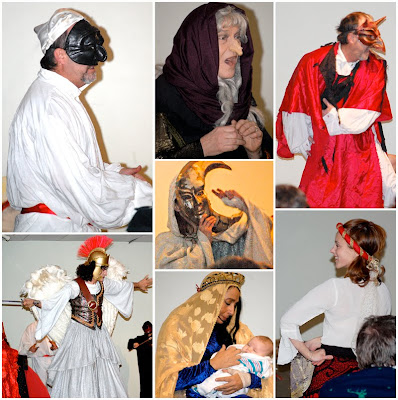By Giovanni di Napoli
Last Sunday I had the good fortune of attending Alessandra Belloni's rendition of La Cantata dei Pastori (The Song of the Shepherds) at the Church of Most Precious Blood, in Manhattan's Little Italy. It was only fitting that this classic Neapolitan tale be told in the heart of this once vibrant Neapolitan neighborhood at the shrine to San Gennaro, patron saint of Naples. Credit must be given to the Neapolitan Federation and the Region of Campania for organizing the show and generously providing a wonderful meal afterwards.
In this age of high tech special effects and over the top theatrics it was refreshing to see a performance reminiscent of traditional Opera Buffa. One gets the feeling that we witnessed a show performed the same way it has been for centuries in Campania. The performers' passion and talent, not technology, breathe life into the story and created a wonderful illusion.
 Ms. Belloni, an accomplished percussionist and vocalist (mezzo soprano), was accompanied by her usual ensemble of talented musicians and performers. The troupe is a rare and unique example of Southern Italian folk music outside the Mezzogiorno. In addition to this, they put on the most spectacular performances, filled with capricious dance, acting and story telling.
Ms. Belloni, an accomplished percussionist and vocalist (mezzo soprano), was accompanied by her usual ensemble of talented musicians and performers. The troupe is a rare and unique example of Southern Italian folk music outside the Mezzogiorno. In addition to this, they put on the most spectacular performances, filled with capricious dance, acting and story telling.
The show began with a tune from a zampognaro (bagpiper). This was a special treat for me because I never heard the zampogna live before. For the life of me I can't understand why this ancient and wonderful instrument isn't more popular. As heard at the show, in the hands of a professional, this instrument is highly versatile and enchanting.
For those who didn't understand Italian, Le Befana, the Epiphany witch, narrated the story line in English in-between songs. With the benevolent crone's account it was easy the follow the plot.
What I found most interesting about the story is how the Neapolitans, in an ethnocentric display of piety, not only included themselves in the birth of the Messiah they gave themselves a prominent role. Much like they do with the presepio, the Nativity is given an unmistakable Neapolitan twist. If one didn't know any better, one would believe that Christ was born in Napoli.
Razzullo, dressed like Pulcinella (the representative character of Naples in the commedia dell'arte tradition), is the story's protagonist. Lost, the foolish but likable Neapolitan finds himself in Bethlehem. During his sojourn he repeatedly crosses paths with the Virgin Mary. The unlikely hero, with the help of the Archangel Gabriel (of course), thwarts Satan's plan to murder the Madonna.
Without a doubt, the highlight of the show was the death of Razzullo. The crowed was in stitches as the endearing buffoon, amidst the wailing mourners lamenting the loss of their hero, kept rising from the dead to sing his part of the dirge. (Members of the audience were still singing it after the show.)
The show came to a close with the entire troupe singing a somber ballad honoring the birth of Christ. During the adoration celebrating motherhood and life, Ms. Belloni held in her arms, in a touching moment of tenderness, a beautiful infant representing the Christ child.
 |
| Actors (L-R): Giuseppe De Falco (Razzullo), Max McGrath (La Befana), James Karcher (il Diavolo), Mark Mindek (Archangel Gabriel), Alessandra Belloni (Madonna), Luisa Silvano (Baby Jesus) and Francesca Silvano (Dancer) |










